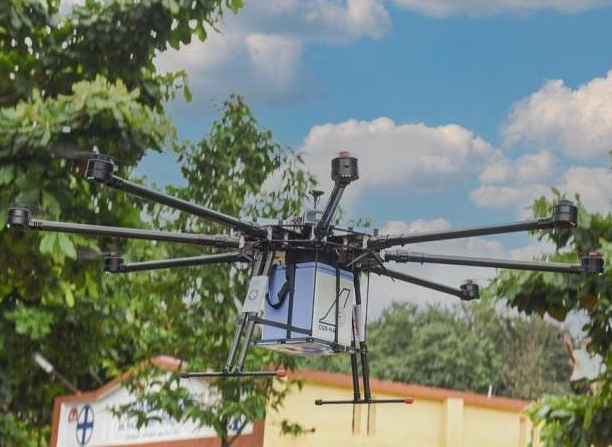Bengaluru: An indigenous, medium class octacopter developed by the state-run National Aerospace Laboratories (NAL) Saturday successfully delivered Covid-19 vaccine doses in a remote village in Karnataka, covering an aerial distance of 7 km in about 10 minutes.
NAL is an arm of the Council of Scientific and Industrial Research (CSIR), funded by the Union Ministry of Science and Technology. In September, the Civil Aviation Ministry had granted conditional permission to CSIR-NAL for conducting beyond visual line of sight (BVLOS) flight trials of unmanned aerial vehicles (UAV).
Saturday, the CSIR-NAL’s octacopter successfully delivered 50 vials of Covid-19 vaccine along with syringes in a special container from the Chandapura Primary Health Centre (PHC) to the Haragadde PHC.
The octacopter took off at 9.43 a.m. from Chandapura PHC carrying Covid vaccine doses which they delivered to the Haragadde PHC at 9.53 a.m. The octacopter flew at an altitude of 300m AGL at a speed of 10 metre/sec and covered an aerial distance of about 7 km in about 10 minutes.
After delivery of vaccine doses at Haragadde, the octacopter returned to the Chandapura PHC. The entire mission covered a distance of about 14 km in 20 minutes, including delivery of vaccine doses.
“The octacopter for the delivery of vaccines is a need of the hour for the country,” P.V. Satyanaraya Murthy, Head UAV, CSIR-NAL, said in a statement.
It is perfectly designed “for a much deeper penetration of vaccines in the remote areas”, he added.
Moreover, Murthy said that the NAL “octacopter is easy to operate by unskilled operators”.
He also noted that NAL has already tied up with private firms for drone manufacturing and offering operational services.
The octacopter developed by NAL can be used for a variety of BVLOS applications for last mile delivery like medicines, vaccines, food, postal packets, human organs etc.
It is also integrated with a powerful onboard embedded computer and latest generation sensors for versatile applications like agricultural pesticide spraying, crop monitoring, mining survey, magnetic geo survey mapping etc.
The UAV is made out of light weight carbon fibre foldable structure for ease of transportation and has unique features like autonomous guidance through dual redundant microelectromechanical systems (MEMS) based digital autopilot with advanced flight instrumentation systems.
It can fly at an operational altitude of 500m AGL and at maximum flying speed of 36 kmph, and can carry a payload of 15 kg with hovering endurance of 40 minutes.
IANS

